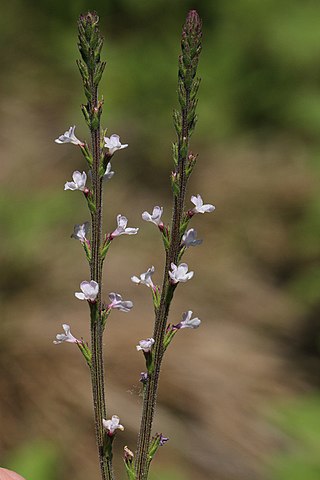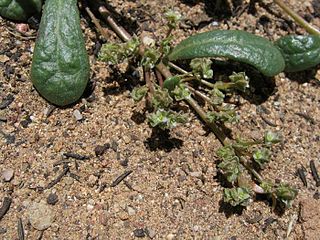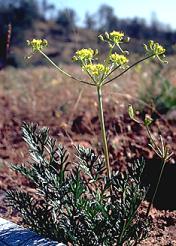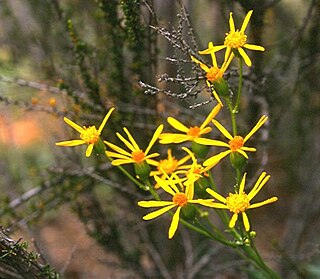
The ecology of the Sierra Nevada, located in the U.S. states of California and Nevada, is diverse and complex. The combination of climate, topography, moisture, and soils influences the distribution of ecological communities across an elevation gradient from 500 to 14,500 feet. Biotic zones range from scrub and chaparral communities at lower elevations, to subalpine forests and alpine meadows at the higher elevations. Particular ecoregions that follow elevation contours are often described as a series of belts that follow the length of the Sierra Nevada. There are many hiking trails, paved and unpaved roads, and vast public lands in the Sierra Nevada for exploring the many different biomes and ecosystems.
The Spenceville Wildlife Area is an 11,448-acre (46.33 km2) wildlife preserve managed by the California Department of Fish and Wildlife. It is located in the Sierra Nevada Foothills, within Nevada County and Yuba County of northern California.

Verbena californica is a rare species of verbena known by the common names California vervain and Red Hills vervain. This flower is endemic to Tuolumne County, California, where it is known from ten or eleven occurrences in the Red Hills, a section of the Sierra Nevada foothills near Chinese Camp. It grows in moist woodland habitat, often on serpentine soils. It is a federally listed threatened species of the United States.

Calochortus striatus, known by the common name alkali mariposa lily, is a species of mariposa lily native to California and into Nevada.

Allium tuolumnense is a rare species of wild onion, known by the common name Rawhide Hill onion.

Calyptridium monandrum, synonym Cistanthe monandra, is a species of flowering plant in the family Montiaceae known by the common name common pussypaws.

Allium yosemitense is a California species of wild onion known by the common name Yosemite onion. Most of the known populations are situated within the boundaries of Yosemite National Park.
Antennaria pulchella is a North American species of flowering plants in the family Asteraceae known by the common names Sierra pussytoes and beautiful pussytoes. It is native primarily to high elevations in the Sierra Nevada from Nevada County to Tulare County, where it is a plant of the alpine climate. Additional populations occur on Lassen Peak in Lassen County, and also in Washoe County, Nevada.

Arctostaphylos myrtifolia is a rare species of manzanita known by the common name Ione manzanita. It is endemic to the Sierra Nevada foothills of California. It grows in the chaparral and woodland plant community on a distinctive acidic soil series in western Amador and Calaveras Counties. There are only about 17 occurrences, but the plant is abundant in some areas of its limited range. This is a federally listed threatened species.
The Red Hills are a mountain range in Tuolumne County, California. Elevations within the Red Hills vary between 750 and 1,750 feet above sea level. Slopes of the hills themselves vary from about 30% to 75%.

Brodiaea pallida is a rare species of flowering plant in the cluster-lily genus known by the common name Chinese Camp brodiaea.

Calyptridium monospermum, synonym Cistanthe monosperma, is a perennial plant in the miner's lettuce family (Montiaceae), known by the common name one-seeded pussypaws. It was formerly classified in the purslane family (Portulacaceae).
Calyptridium parryi, synonym Cistanthe parryi, is a species of flowering plant in the family Montiaceae. It is known by the common name Parry's pussypaws. It is native to the southwestern United States and Baja California. It is a small annual herb producing spreading stems up to about 11 centimeters long. There is a basal rosette of small, thick, spoon-shaped leaves no more than about 3 centimeters long, with many along the stems as well. The inflorescence is a cluster a few centimeters wide, with each bearing three white petals surrounded by a few thin sepals. The fruit is a capsule less than a centimeter wide.
Clarkia rostrata is a species of flowering plant in the evening primrose family known by the common name beaked clarkia.

Lomatium congdonii, known by the common names Mariposa desertparsley and Congdon's lomatium, is a species of flowering plant in the carrot family.

Lupinus citrinus is a species of lupine known by the common names orange lupine, orangeflower lupine, and fragrant lupine. It is endemic to California, where it is known from a section of the Sierra Nevada foothills extending from Mariposa to Fresno Counties. This is an annual herb growing 10–60 centimetres (3.9–23.6 in) tall. Each palmate leaf is made up of 6 to 9 leaflets up to 3.5 centimetres (1.4 in) long. The herbage is coated in tiny white hairs. The inflorescence bears several flowers, sometimes in whorls. Each flower is roughly a centimeter long and orange to yellow to white in color. The fruit is a legume pod 1 or 2 centimetres (0.79 in) long containing seeds which resemble "pieces of granite."

Packera layneae, known by the common name Layne's ragwort and Layne's butterweed, is a rare species of flowering plant in the aster family.

Calyptridium is a genus of flowering plants belonging to the family Montiaceae.

Lupinus caudatus is a widespread species of wildflower in genus Lupinus from western North America known by the common names tailcup lupin and spurred lupin. It is distinctive for the short spur on its purple-blue flowers, for which it is named. Because of its wide distribution and toxicity it commonly causes poisonings of susceptible livestock such as horses, cattle, and sheep, though it is eaten without harm by wild herbivores like deer and elk. It is generally found from the Coastal Ranges and Sierra Nevada Mountains in the west to the Rocky Mountains in the east.















